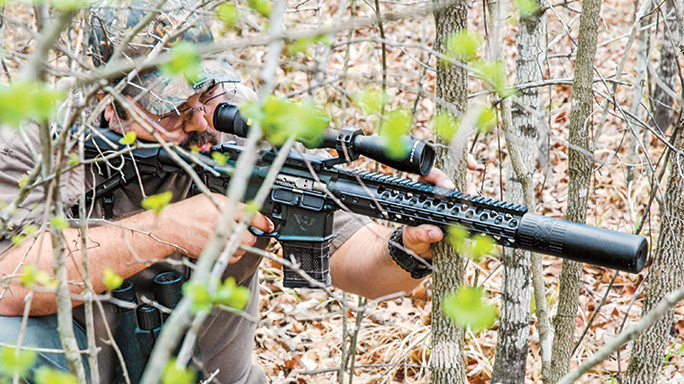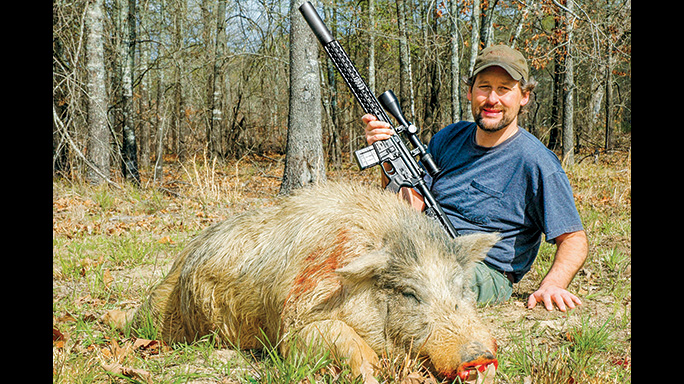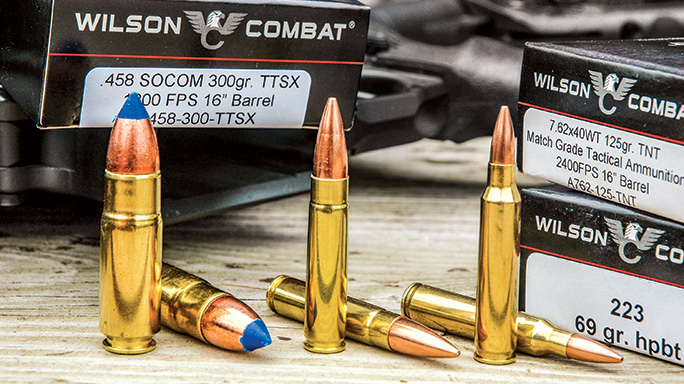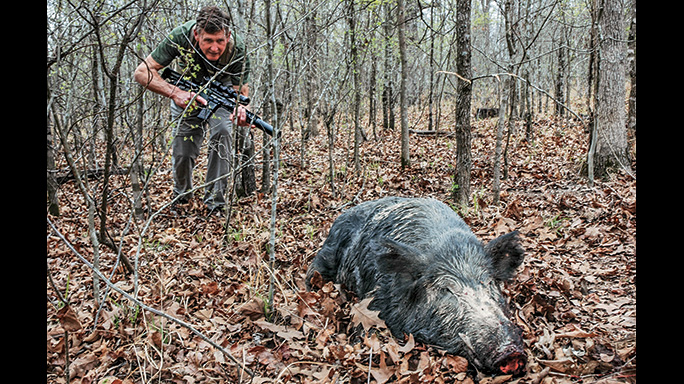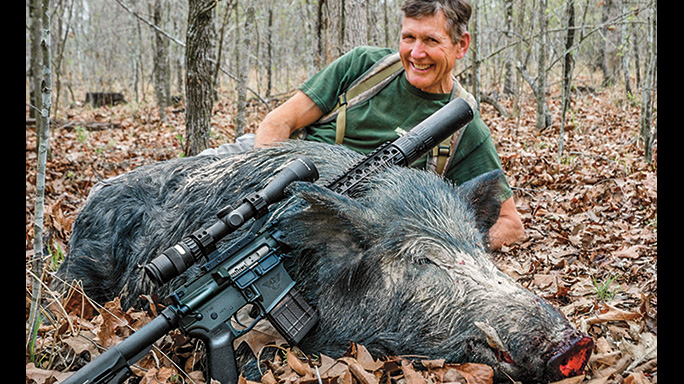There are many ways to shoot a pig. I’ve tried only a few. What seems obvious, though, is that pigs lack the versatility to keep any one tactic interesting. Driven hunts, as practiced in Europe, keep sportsmen engaged mainly because pigs thundering through the forest are challenging targets. You hit lots of trees. At the same time, pigs give you a chance; they move with no more vertical bounce than a heart monitor on a corpse. And pigs tagged at the gallop deliver a spectacular finish.
- RELATED STORY: Gun Review: Wilson Combat’s Super Sniper
On the other hand, hunting pigs from a stand without a gaggle of Germans and Poles beating them to you is a thumb-twiddling test of patience. Dark skies get darker over a dark pile of corn. The pigs don’t always come. In the Old Country, on snow, the only sure thing is that you’ll get colder with the night. And because pigs often come after dark, and night hunting is legal, you’re expected to remain in place as frostbite sets in.
Stateside, a few hunters add variety to pig hunting by chasing them with spears. For me, pistols are challenge enough. A 1911 in hand, I’ve crawled through snake cover on the heels of foraging porkers. As my effective range with a .45 ACP matches that of a medieval pikeman, spear-clutching hunters have nothing on me.
Advertisement — Continue Reading Below
But what options do you have when you’re a guest and the pig population has spiked, and your host is drafting barricades to stem the porcine invasion?
“You gotta shoot some hogs.” Bill grins encouragingly, as if that’s what you want to do anyway and he is merely giving the benediction. He hands you a GI ammo can full of .223 cartridges squirreled away before Joe Biden pronounced AR-15s unnecessary and adds, “There’s more where that came from.”
It’s Texas. No doubt there’s more.
Advertisement — Continue Reading Below
Waiting Over Corn
But you don’t want to plug a pig over corn. It isn’t that corn is un-American. When Nikita Khrushchev first visited our heartland, he didn’t rave about its missile silos, bomber bases or ammunition factories. He stood in awe of our corn. Those of us old enough to recall his shoe-banging on conference tables knew that Crude Niki was hardly stupid. He, a product of peasant agriculture in a harsh land, astutely traced the throbbing pulse of America’s military might to the fertile soil of its breadbasket. Landscapes crowded by corn, granaries bursting with corn, freight trains laboring under the weight of corn—these impressed the man who had said, “We will bury you.” He knew then that they could not.
Pigs aren’t much into history. They’ve no military-industrial complex to fuel with carbohydrates. But they’re enthusiastic about corn. Corn remains the Achilles’ heel for all of porkdom. Corn brings otherwise sagacious swine into rifle sights. Corn makes hunting pigs an exercise in shooting pigs. Now, where hog numbers have reached critical mass—where, if they could fly, pigs would darken the skies from horizon to horizon—shooting pig is just fine. “Thin ’em out.” Is there desperation behind that drawl? Wilson hands me another ammo can.
Advertisement — Continue Reading Below
I’ve done this drill. You place a stool where red ants haven’t yet homesteaded, and you keep one eye on the corn while the other cruises a tattered novel scrounged from the pile of paperbacks in the bunkhouse. A red sun sinks behind the oaks. The corn castle 80 yards hence was freshened this afternoon, courtesy an F-150 dating back to the Cold War. The pigs heard it. They know. When the light gets too dim even for the salacious sections of your book, you check the safety on the AR and listen hard. Is that a squirrel rustling the oak leaves? An armadillo? The whitetail deer left half an hour ago, after nosing, then nibbling at the corn. There’s plenty left.
Upscale hosts can make long preludes more tolerable with elevated stands. In my youth, such perches comprised a web of 2x4s in a tree crotch. These days, commercial freestanding boxes are roomier than the housing I rented in grad school. Equipped with silently moving windows and executive chairs, they’re airport-lounge comfortable. Cans of industrial-strength insecticide arm you for battle against the ubiquitous wasp, a huge fan of Texas deer towers. Downrange, the pile of unshelled ears has given way to an automatic feeder that comes alive at preset intervals to scatter fresh corn. The rattle is a dinner bell for hogs.
Some states let you add bulbs to light up porkers accustomed to men leaving the woods at dusk for appointments with Johnnie Walker. The hour after sunset often brings action at the corn.
Advertisement — Continue Reading Below
“You didn’t shoot?” Bill Wilson had cultivated this woodland for trophy hogs. In fact, its fenced periphery included pens baited with corn. Hogs traipsing in to chow down would trip a steel grate that fell behind them. Bill could then open a door to his old men’s club, or reset the gate and boot sows and piglets back into the surrounding forest. From my tower this evening, I had watched a pair of fine boars, probably pushing 200 pounds, jostling for the corn. They’d been at it an hour when, just after sunset, a third pig arrived. My rifle, a Wilson Combat AR in .458 SOCOM, was certainly up to the task. But I wasn’t. That trio of tuskers was chomping corn under red lights when I slipped from the blind and padded through the timber to the road.
“I just didn’t feel like it.” No, I didn’t really say that—I caught myself just in time. Nowhere outside of Austin does “feel” pop up in Texas dialogue.
“Nope,” I replied.
Advertisement — Continue Reading Below
“Should have,” Bill shrugged, then looked off the way he might have if instead I’d botched a slow-fire string with one of his custom-built 1911s, or missed a plate from sandbags with the AR that had punched a sub-walnut group for me at 200 yards. “Pigs are to shoot.” He added that I had hiked in mighty early. It was only 9 p.m.
Still Movin’
We ate very well that night—those who’d killed pigs and he who hadn’t. Bill and Joyce are charitable people. A flavorful elk roast that flaked from a fork, with hot pinto beans, mashed potatoes and cornbread, paved the pallet for blue-ribbon cobbler. I’d kill a pig for that cobbler. Shamelessly, I dished up twice.
Advertisement — Continue Reading Below
“How about stillhunting?” No plan for an assassin, it would add a bit of sport to this adventure. Bill allowed that the litter was dry, and it’d be tough, but that I could try it midday, then sit on the corn. A diplomatic offer. Bill’s son, Ryan, who now runs Wilson Combat at the company’s Arkansas shop, kindly agreed to play the guide.
We eased into the reserve on a trail, then cut through the oaks upwind, pressing our toes slowly into the brittle leaves. Brush limited visibility to slingshot range and less. You needn’t look for sneaking pigs, because pigs haven’t yet learned to sneak. But they hide well. “Early afternoon, they bed in thickets,” said Ryan. “You have to look sharp, be ready to shoot.” Though the rangy frames and long snouts of the animals taken by my comrades signaled a genetic link to Russian or European wild boars, Texas’ own feral hogs have contributed heavily to this pool. “Expect all colors. Try to find an ear.”
He’d just whispered that hint when a pair of pigs shot from a downed tree. Thick, tall boars, they galloped off a short distance, then paused. A small alley gave me a raking shot to the rearmost hog. But while Ryan stood safely to the side, my carbine’s muzzle hung uncomfortably close to him. The .458 SOCOM delivers a snappy report, even with a suppressor. Besides, Bill had warned me against raking shots. “Hit a boar between the shoulders from the side with that 300-grain TTSX at 1,800 fps, and you put bacon on the ground,” he said. “But quartering shots are chancy. Pigs don’t bleed well without an exit hole, and even when fatally hit, they can go far enough to lose you. Be careful.”
Advertisement — Continue Reading Below
I let both pigs scurry off unmolested. The forest swallowed them immediately. I was surprised they made so little noise. “Tiny, pointy feet,” grinned Ryan. “An occasional boar scales over 300 pounds, but you wouldn’t know that, hearing them move.”
We continued on, but within a few yards my pal suddenly halted, bending forward to peer through branches. I eased forward, followed his gaze and spied the ear even as he pointed. The bedded pig showed me little else, so I crept forward. Destination: a nodding sapling that might steady my rifle. I had not reached it when the boar spotted my movement and rose. I steadied the Aimpoint sight’s red dot as best I could off-hand and pressed the trigger.
Slammed by the fat Barnes bullet, the porker showed no sign of a strike but sped off. I could have fired again, but swinging the stubby AR, I caught only snippets of pig behind a heavy lattice of oak, redbud and alder. Just as the boar vanished, I saw its off shoulder sag. We ran after it. The pig lay dead just a few yards farther, the leaves around peppered by blood spray.
Advertisement — Continue Reading Below
“Big boar!” exclaimed Ryan. “Well over 200 pounds.” Having watched the scale needle spin under the weight of other carcasses on Wilson’s ranch, I had come to appreciate the heft of these dense, stocky creatures. This one would later register 210 pounds.
Challenges Afoot
That evening I sat again over corn. Five whitetails, all bucks, arrived to sift it with their hooves. Though most of March had passed, one of the deer still carried an antler. No pigs came, sparing me a decision. The next morning, Bill suggested we get “a meat hog.” Mature boars are, by universal acclaim, inedible. “But a young pig, say, up to 70 pounds, is tender and tasty. Great barbecue.” And who was I to lecture a Texan—even a transplant from Arkansas—on barbecue?
Late in the afternoon, we hopped in a Ranger to cruise the meadows, swamps and forests comprising the nearly 9,000 acres Bill has adopted as his retirement home. He’s still “proving it up,” with hunting towers and watering tanks, and automatic feeders with red lights “to get those shy old boys that let the young pigs at the corn first.” He’s rocked several roads for all-season access, and plans selective logging to keep the bottomlands attractive for hogs, deer and turkeys. New outbuildings include a handloading facility as comfortable as most cottages, and a lodge with a trophy room as big as a gymnasium. Ranks of plates on action-pistol ranges complement gongs and pop-ups on carbine courses, and a rifle range with steel out to 600 yards.
Lightning had awakened me before dawn this final day, followed by gentle drum rolls of rain on the roof. “We got nearly an inch,” Bill said, herding the Ranger along a muddy track. Water glistened from hollows parched for months. The rain was most welcome.
We spied some pigs on the far side of a big burn, greening up with the season and promising more grass on the heels of the rain. In the distance, litters of piglets scampered after sauntering sows. We motored on. Another group crossed our path. When Bill spied a swarm of half-grown porkers, we took to our feet and galloped after them through thick woods. They slowed in even heavier cover. So did we, eventually closing stealthily on a young red boar. Briefly, his ribs came clear in a slot. I fired off-hand with a hastily planted shooting stick. My rifle this day was a Wilson AR in 7.62×40 WT with 1-in-12-inch rifling spinning 110-grain Barnes spitzers from the altered .223 hull. “That bullet was pretty much designed for the case,” Bill said. “It’s lethal.” Then, as the hog had vanished: “Did you call a good shot?”
- RELATED STORY: Semi-Auto Hammer: Wilson Combat’s Recon SR Tactical
I had. We found the pig right away, double-lunged and dead. A firehose blast of blood coated the bushes and swamp grass for yards leading to the animal.
There are many ways to kill a pig—some harder than creeping through Southern woodlands. But afoot in cover, you’ll find hogs have good noses, keen hearing and little tolerance for hunters. You’ll have to look sharp, and sometimes shoot quickly. You won’t fall asleep reading.
For more on Wilson Combat, visit wilsoncombat.com or call 800-955-4856.
